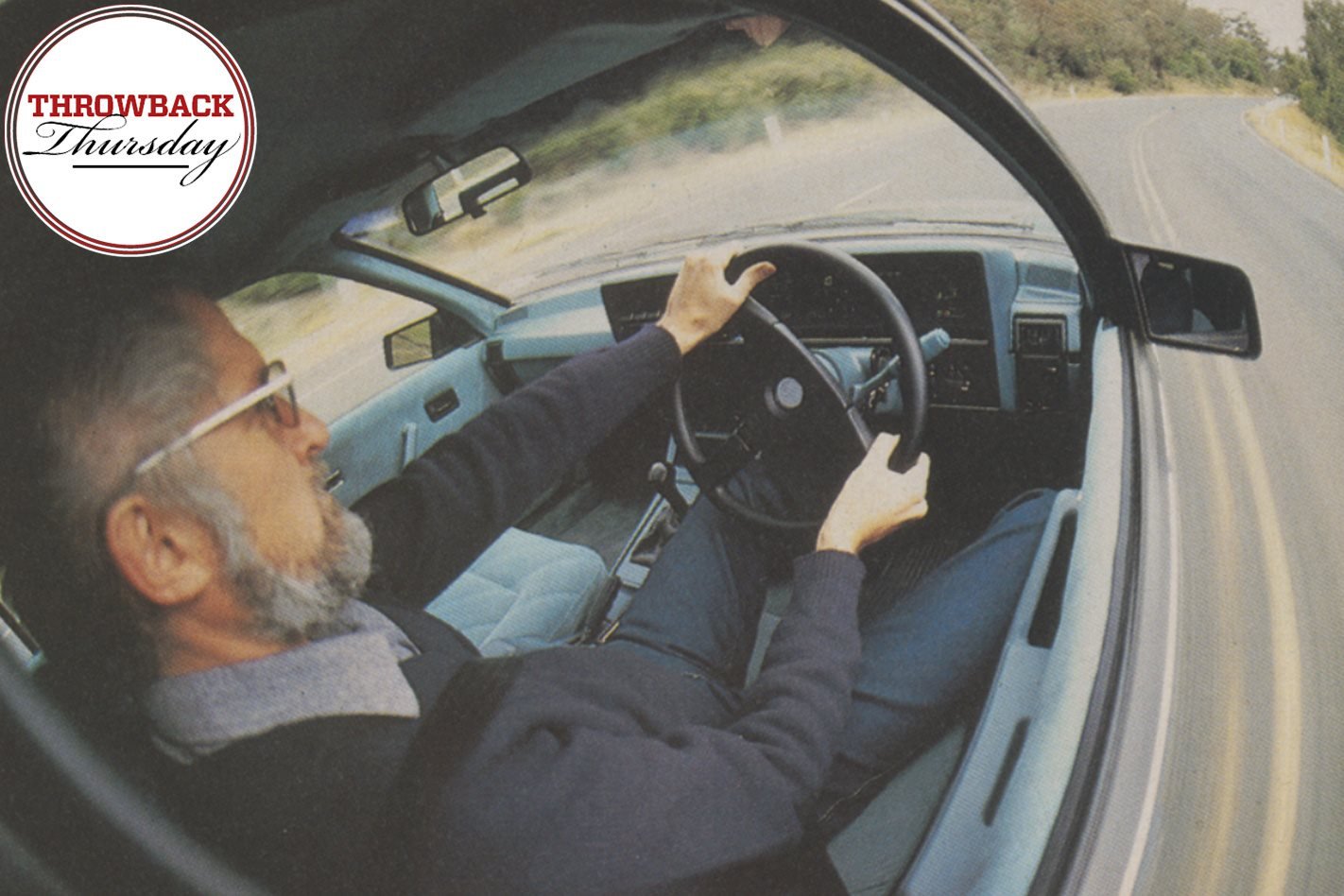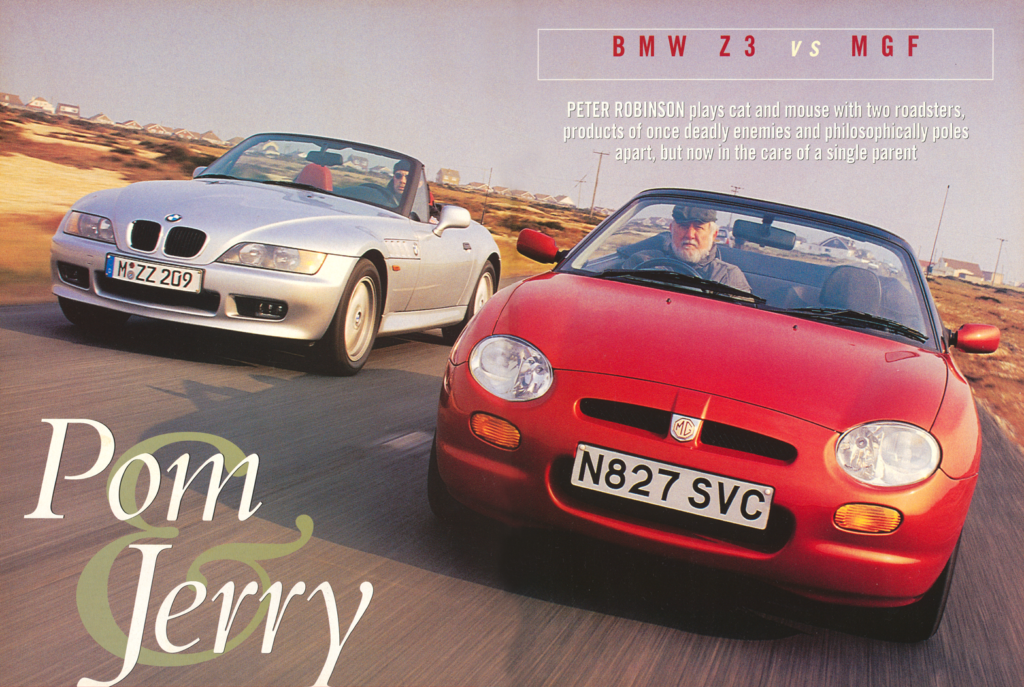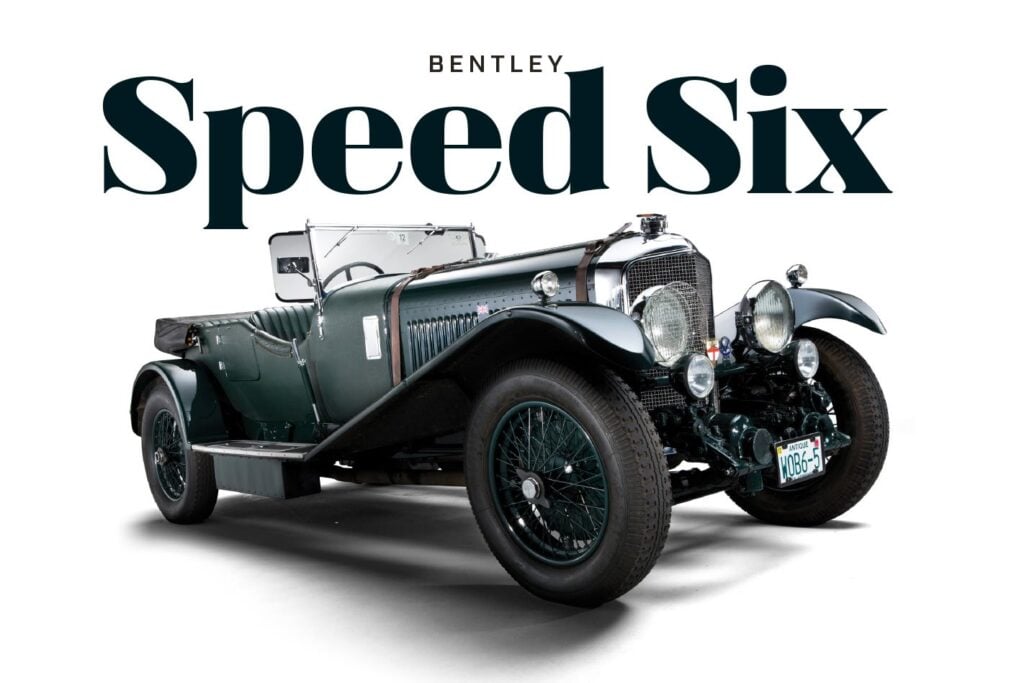Is the Brock-developed Calais Director as good as everyone hoped it would be? Peter Robinson reports it’s even better.
First published in the October 1985 issue of Wheels magazine, Australia’s most experienced and most trusted car magazine since 1953.
WHAT a tempest we raised. The stream of letters continues unabated, and even Peter Brock himself saw fit to voice his objections to the findings of our now infamous Brock Versus Europe comparison in the May issue.
 Driving Velvet Thunder – October 1985
Driving Velvet Thunder – October 1985
View this article in its original format in the archive.
The accusations flowed. We were incredibly biased and totally subjective; the choice of cars for the comparison was invalid. Thr supporters of Brockmobiles came out of the woods to stand up and be counted. The local hero and his cars have many followers; many of them demanded a rematch using a Calais Director as the weapon.
We still stand by our May findings, based on the cars we drove for that test. We concede, certainly, that the Group Three tested was a hard-working mule and that, of course, the Director would have made for a fairer, closer contender in the Executive Express fightout. We knew that. The problem was that, at the time of doing the test, a Brock Director was a rare beast indeed and it seemed unlikely to join Holden’s fleet. So, after the original Group Three test car was stolen, we were forced to make do with what was available. But biased- from the magazine that wrote of the HDT SS VH Commodore in 1982, “if it’s not the best sports sedan for the money in the world, I’ll stand rooted,” – no way.
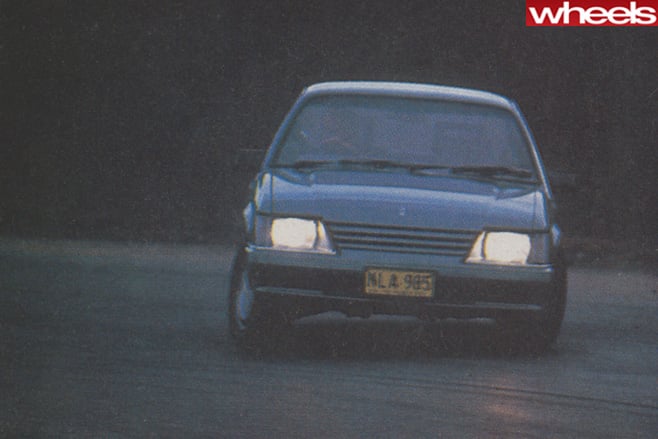
And that, gentlemen, is what has come out of the giant playpen that is the Holden Dealer Team car-building operation. This is quite a car, by any standards, for it will run with the best four-door sedans in the world, in any performance test devised. Yet it can be idled around in fifth gear from well below 1000rpm before stretching its long legs to 4600rpm, and that is 237km/h. Don’t ask where, but we can now reveal that Holden’s digital speedometer stops working at 192 km/h and refuses to read anything higher. The tacho, however, continues on and at 3.30am on a deserted road it climbs and climbs, taking the Director beyond even the 228km/h we recorded from the Phase Three GTHO Falcon back in 1971. Until now that was the fastest four-door sedan Australia had ever produced.
We began with a VK Calais with the hi-performance VS engine and manual transmission. List price, $22,373. Take that up to Director level for another $5296 and you have a $27,669 Holden Commodore. We wanted to go further and ordered the Borg WamerT5 gearbox both for its taller gearing, with the long 0. 73 overdrive cog, and for its shorter first gear. The price of an extra ratio is not cheap at $2850, but the benefits go far beyond just another gear with which to play around.
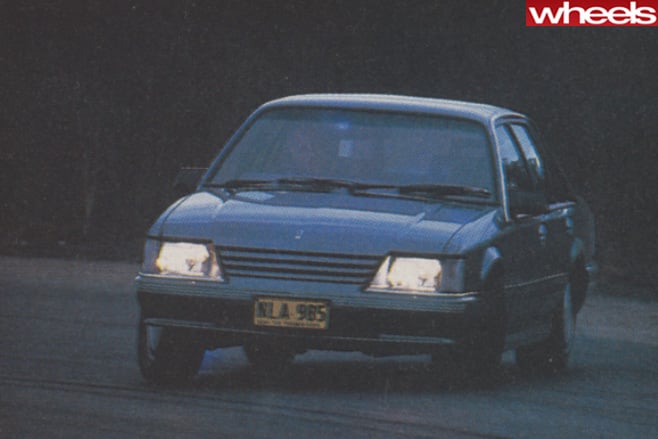
The long-range 90-litre tank ($332) was considered mandatory if the car was to have a respectable touring range; a Cobra alarm system ($585) seemed like a good idea to protect GMH’s investment; and for high speed work at night we ordered up 130/90W headlights which require a new relay and wiring harness and so cost $93. And, at dealer level, we opted for the sports exhaust system that the HDT says gives an extra 37 kW or thereabouts and certainly sounds much more potent than the standard system that is shared with the EFI six.
Eventually we drove away in $32,274 worth of Commodore, sceptical that any amount of Brock magic could justify more than doubling the base car’s price. We were disappointed in our choice of colour – the Spindrift, a darkish metallic blue, was just too bland – but immediately impressed by the quality of the T5’s gearchange. What a pleasant surprise, and so vastly superior to the notchy, stiff change produced by Holden’s old and noisy M21 box it’s a shame the five-speeder isn’t standard equipment. Movements between ratios are small and firm, yet the change is lighter and far more precise, while the clutch seems less heavy than on the Holden Commodore Group Three and is more progressive.
Fifth gear is there to be used, and despite the knowledge that it is very tall it feels quite logical, natural even, to change up from fourth at 60 km/h, barely over 1000rpm, and we learned quickly that it would even pull from 500 rpm without protest, such is the immense torque of this engine. What joy to have a five-speed box on the end of a large capacity V8! And the car is so much quieter; it is only when starting up, as the engine bursts into life, that it sounds like Brock’s Group A racer, that the occupants inside the car are aware that this isn’t any old six cylinder Calais. Unless they wind down the windows, of course, for then there is the constant, mostly subdued bent-eight burble that informs the knowing that this car is truly potent.
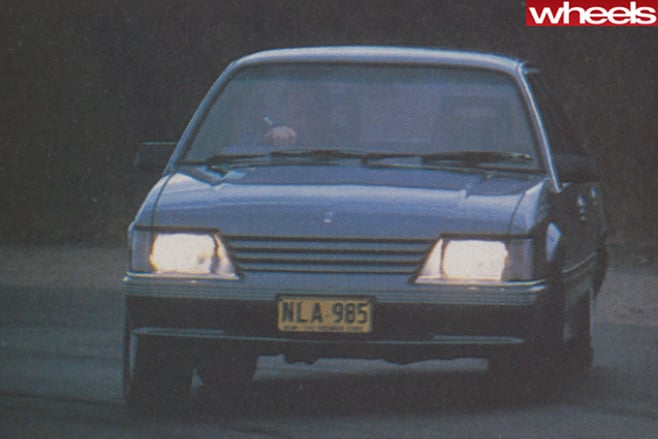
The customers, those buyers for whom money seems no object when it comes to the purchase of the ultimate Commodore, are going to find the changes to the suspension only emphasise the marvellous dual character that makes the Director so appealing.
On the one hand it can be motored around the suburbs, taken shopping or to pick up the kids after school, without intimidating the driver or drawing unwanted attention. Lazy drivers will love the way it encourages changing up early, bypassing a couple of ratios on the way to fourth, and the car has the torque to be left in fourth down to a crawl.
And yet the thunder is only a down-change and a floored accelerator away. Holden’s bent eight is transformed into a responsive, free revving, and surprisingly smooth engine by throwing off the standard exhaust system that is shared with the EFI six. This single pipe set-up not only strangles the power output but produces a nasty stifled exhaust note that is completely at odds with the image Holden has been promoting for the V8. The sports exhaust allows the engine to breath properly so that the Calais electronic tacho’ s red line of 5600rpm is realistic and 300 or 400rpm below the point where the hydraulic valve lifters begin to pump up. On our engine 6000 was achievable in fourth gear …
This is not a brutal engine in the manner of the GT HO Phase Three, but rather an engine with seemingly endless torque and the ability, more pronounced than in any other Holden bent eight we’ve tested, to rev cleanly and quickly to the redline. A tickle of the accelerator is more than enough in most driving situations; press a little harder and change up between 2500 and 3000rpm and you will leave the traffic behind. Push deep into the relatively short throttle travel and you will find that this is the fastest accelerating four-door sedan sold in Australia.
Yet it doesn’t feel as quick as the Group Three, nor as boy-racer, because it has a refinement and composure that has been lacking in all previous Brock Commodores. So deceptive is the car that we anticipated a standing 400m time of mid-15s yet we couldn’t have been more wrong. Our first run, heavy on wheelspin but clean and quick, stopped the computer read-out at 14.85 seconds. Second run, with marginally less wheelspin, dropped this to 14.78 and still we felt it would go faster.
Third attempt was perfect: wheelspin to about 40 km/h, the tail not getting twitchy the way it had on the first go, the clutch biting home quickly and smoothly and the gear changes swift and sure with the change from third to fourth coming only moments after we crossed the end of the 400m. Time: 14.64 seconds. A fourth run produced 14.84, by which time the tyres and road surface seemed to have given of their best.
Perhaps even more impressive were the in-gears times for they showed that while this engine was marginally slower down low it was clearly quicker in both the mid and high rev ranges. Even so, the Director staggered us by pulling from 30km/h in fifth gear and achieving a 30-60km/h time of 9.9 seconds to make the BMW, Volvo and even the mighty Saab seem totally lacking in flexibility by comparison. Yes, the Holden does have a huge capacity advantage; but then it does make the most of it, so who is going to argue?
Let it be said, once more, that the Calais Director with five-speed gearbox is exactly the car we should have had against the Europeans. All our letter writers can bask in the glory of being right.
Perhaps at this point we should sort through the confusion surrounding Holden bent eights. The present 4.9-litre small-valve automatic develops 117kW at 4400rpm and 328Nm of torque at 2800 rpm. Codenamed LV2, it is the base engine until the V8 is converted to run on lead-free fuel around the middle of ’86.
The old V5H V8, used in manual versions of the Commodore, gave 129kW at 4400 rpm and 347Nm at 2800rpm. The 4.9 engine fitted to Group A Commodores for street use gives 134kW at 4400rpm and 328Nm at 3200rpm but this engine has the standard exhaust system and for those customers – read most – who want to retain the acceleration of the old Group Three the sports exhaust option takes this to 196kW at 5200 and 419Nm at 3200rpm in blue-printed form. That’s with the wild-for- street-use Wade 169 cam.
Our engine, smooth and quiet as it is but with the standard camshaft timing (as used by Brock in his race car, which also has the exhaust option), gives 170kW at 4800 rpm and 417Nm at 2800. A compromise, we believe, that is ideal for everyday motoring.
In GM-speak the engines are given code names. The VT referred to the old five-litre engine; VA is the 4.9 auto, VB the 4.9 manual and VC the Group A, while those engines with the big-valve heads have a B cast into the heads (but it can be at either end of the engine). To add to the confusion the first of the 4.9 engines all came with the big valves but from July production – and in order to build the required 5000 identical engines for racing purposes – the bent eights got small valves although all of the ’85 1/2 Group Three and Director engines are converted to big-valve specs by the HDT.
The full-blooded acceleration runs induced a nasty vibration in first and second gear that we felt came from the tailshaft. Be warned that unless the constant velocity joints are dead straight such a vibration is common with the five-speed box. The rubber centre joint for the tailshaft is quite soft and this contributes to the trouble. We complained of the problem at the first service and it had been cured when the car returned, so it is obvious that the problem has been solved.
BorgWarner’sT5 box does more than anything else to transform the Commodore, not only by providing an additional ratio but by improving the quality of the gearchange. It’s not light and rubbery in the manner of many small Japanese cars but positive and precise, a touch notchy perhaps, and completely in character with the car. The ratios are wider than those of the old M21 box with a lower first and virtually identical second, third and fourth ratios while fifth is tall beyond anything Holden has ever offered before. With the same final drive ratio of 3.08 and on the P6 Pirellis – the spec in which we ran the performance figures – fourth gear is 39.4km/h per 1000rpm compared to the Group Three’s 37.6km/h on the P7s, and fifth 53.3. Changing over to P7s reduces the fifth gear ratio to 51.5km/h per1000 rpm.
If, on most counts, it seems the Director answered most of our criticisms of the Group Three, it took no more than a respectable drive to realise the massive 235/60 Pirelli P6s were indeed too big for the car. Over bumps, when the car was loading up in hard cornering, the top of the tyre touched the guards.
More importantly, the steering was very sensitive at the straight ahead and the car felt as if it needed constant corrections to maintain a straight line. The tramlining we complained of in the previous car wasn’t present but the nervousness of the steering meant the car became tiring to drive and any corner seemed to require a series of small bites at the wheel rather than one smooth movement.
Ideally we wanted 225/60 tyres but the new Pirelli 600 is still a few weeks away; so the P7s were tried. Ride comfort suffered hardly at all, despite their low profile – which is a tribute to the Commodore’s suspension – but there was evidence of tramlining over bumps, especially under brakes. The steering, however, had lost the over-sensitive feel apparent on the P6s and cornering was far more accurate and progressive.
Basically this Calais will do exactly as the driver wishes. Our photographs prove it can be made to oversteer if too much power is applied in a slow corner in second gear and ultimately it will always be the tail end that moves out first. But this is such a potent machine with such enormous reserves of roadholding that it has towering point-to-point ability. If bumps may provoke the rear axle into tiny sideways movements under power they do nothing to upset the Director’s overall poise and balance.
One fault that has come to light is that when fully loaded the tail drops sufficiently for the steering to become disconcertingly light and the handling suffers accordingly. This is most obvious on the P6s, where it was felt through the steering, but is still apparent on the P7s.
Only wind noise, that bane of the Australian car, prevents the Calais from becoming the ultimate long-distance touring machine. Strangely the noise that seems too loud at 120km/h doesn’t increase noticeably until around 180km/h so it is only the difference in roar from around the A-pillars between 100-120km/h that creates the impression of excessive wind noise. As expected, the tyres hum over certain surfaces.
What are we to make of this car? We’ll let the figures speak for themselves and only say that if we could throw away the instruments – whether they be the horrid square dials in the base Commodores or the digital affair in the Calais – and reduce the wind noise then there would be no other sporting sedan in the world that could touch the Director, at least in Australian conditions. The status quo has returned.
Seeing red
How angry were readers in the wake of the “Brock versus Europe” story that appeared in the May 1985 edition? Here’s one of the letters in full, sent in by Warwick Armstrong.
***
To the editor,
I believe your four-way road test of the Saab, Volvo, BMW and Brock (WHEELS May) was biased and subjective. Before you get your exercise jumping to conclusions, I am not pro-Holden or pro-European. I have owned a wide variety of cars including BMWs, Peugeots, VWs, a Fiat, two Minis, a Renault, a Honda and various Fords and Holdens. My present car is a 1981 Brock Commodore.
The comparison was strange in that you compared the base-line Brock with cars costing up to $16000 more. I can buy the Brock as tested and have enough left over to buy an Alfa 33. The fact that the three Euros are much cheaper in their home country is irrelevant. Surely the buyer’s value for dollar here in Australia is what should be under test.
From my experience the person who buys a Brock is after power and handling at an affordable price. Even if the prospective Brock buyer could find the considerable amount of extra cash (approximately $300-$400 extra per month for leasing), he would end up with much less power and inferior handling. The Euros have undoubtedly superior finish and in some circles more prestige, but none of them has the blend of room, handling and power that the Brock offers, despite the massive price difference.
You also play down the real performance gap between the Brock and the Euros. The BMW is incredibly slow and can only perform under Australian highway conditions by constant gear changes. Most of the people who can afford these cars are past enjoying “rowing” a car along and wringing its neck to get what is then only mediocre performance. For example, in the common 100-130 km/h overtaking range, the Brock is faster in top than the BMW can manage in third.
In fact, the BMW is only marginally faster in fifth from 100-130 than the little Toyota Corolla tested in the same issue.
The Saab has far better performance than the BMW but still requires a gear change down to fourth to match the Brock in the common highway 100-130 km/h acceleration bracket and is a full second slower to 100 km/h. All these performance differentials would, of course, be dramatically increased with a full load. I can’t imagine what the BMW would be like with mum, dad and the kids and a full boot!
The Saab is also very small in comparison with the Brock which itself is only just comfortable for four 1.9m occupants. The Saab would be quite uncomfortable, having 35mm less overall legroom and 130mm less front shoulder room. On top of this it has only two doors – a pain.
Many people buying a Brock expect it to handle a heavy trailer: or perhaps a caravan, which it will do with ease because of its massive torque. Can you imagine the Saab taking off uphill on a rainy night with a load of passengers?
The Volvo appears to be a nice car for older, more sedate drivers who are more interested in luxury than performance or handling. It in no way comes up as a car that a person desiring the Brock’s all-round abilities would even consider. You show the Brock as having a rev limit of 5000rpm and therefore a top speed of 188km/h. The Brock has a rev limit of 5500rpm which converts to 206km/h. My Brock will easily exceed 5500 in top and has a conservative top speed of 210km/h.
The whole comparison is unreasonable. The Brock is simply the fastest, best-handling, family-sized sedan around. You have to pay much more than the $37-41,000 of the three Euros to buy any car which will outperform and out-handle it, especially in the give and take overtaking situations experienced on Australian highways. It makes no claim to be a luxury car. It is what it is and the three Euros cannot match it at its game.
A more reasonable comparison would be the Brock Director which is based on the more luxurious Calais which has higher quality interior trim and fittings, is far quieter and much more likely to be considered by the prospective Euro buyer. I’m sure you would find it a more suitable machine in this European company, and it’s still $7-11,000 less.
You have compared the wrong car, made basic rev/speed mistakes and have made little of the areas of performance, handling and room where the Brock has superiority, yet you have criticised it in areas about which it makes no claims. It is obvious that you set about to “knock the Brock “.
Warwick Armstrong, Grenfell NSW
PRICE AND OPTIONS
Make Holden Model Calais Director Base Price $27,669
Five-speed gearbox $2850 Automatic transmission $466 Power steering stnd Airconditioning stnd Alloy wheels stnd Metallic paint stnd Sunroof $1627 Stereo radio/cassette stnd Price as tested $32,274

